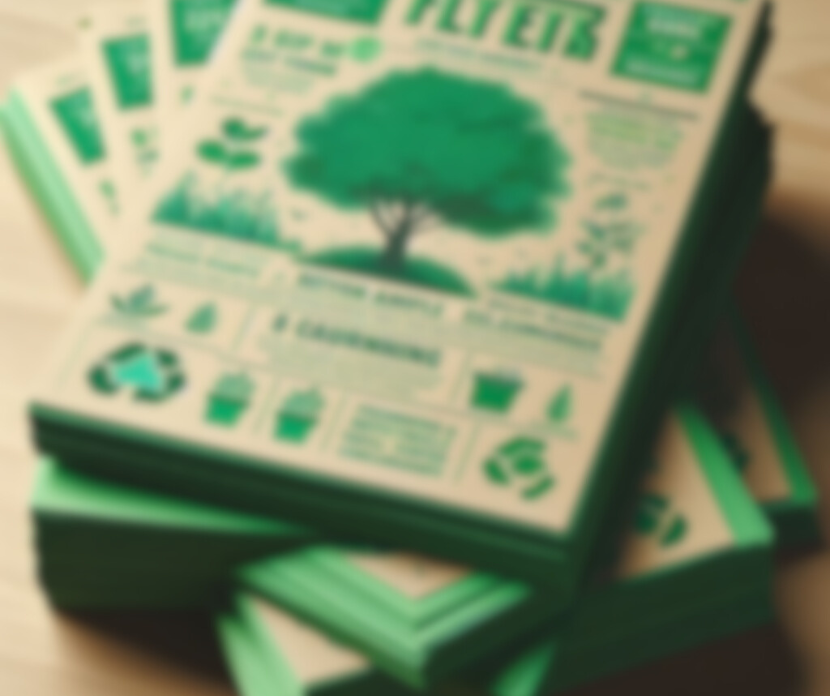In today's increasingly eco-conscious world, businesses are looking for new ways to market their products and services while reducing their environmental impact. Traditional marketing strategies, such as leaflet distribution and direct mail, have long been common in the advertising sector. However, as public concern about climate change and environmental degradation grows, businesses are increasingly resorting to eco-friendly options to reach their target audience.
Enter eco-friendly leaflet distribution and direct mail – sustainable solutions that allow businesses to promote their brand while reducing their carbon footprint.
Why Go Green?
Before delving into the specifics of eco-friendly leaflet distribution and direct mail, let's explore why businesses should prioritise environmentally sustainable marketing practices.
Environmental Responsibility:
Adopting eco-friendly marketing practices demonstrates a company's commitment to environmental stewardship, appealing to environmentally conscious consumers.
Brand Image:
Embracing green initiatives enhances a brand's reputation and fosters goodwill among consumers who prioritise sustainability.
Cost Savings:
Implementing eco-friendly strategies can lead to cost savings over time by reducing paper usage and minimising waste.
Eco-Friendly Leaflet Distribution
Traditional leaflet distribution entails printing and delivering thousands of fliers to homes, businesses, and public places. While this strategy is effective for reaching a large audience, it often generates a lot of paper trash and pollutes the environment.
Eco-friendly leaflet distribution seeks to mitigate these negative impacts by incorporating sustainable practices:
Recycled Paper:
Utilising recycled paper for leaflet printing reduces the demand for virgin paper and minimises deforestation.
Vegetable-Based Inks:
Vegetable-based inks are derived from renewable resources and produce fewer harmful emissions than traditional petroleum-based inks.
Targeted Distribution:
By carefully targeting distribution areas based on demographic data and consumer behaviour, businesses can minimise the number of leaflets printed and distributed, reducing waste.
Direct Mail with a Green Twist
Direct mail initiatives transmit marketing materials, such as postcards or brochures, directly to consumers' mailboxes. Traditional direct mail, while successful in generating leads and increasing sales, can contribute to excessive paper use and waste.
Here's how businesses can make their direct mail campaigns more eco-friendly:
Opt for Sustainable Materials:
Choose recycled or sustainably sourced paper for direct mail materials. Additionally, consider using alternative materials like seed paper, which recipients can plant to grow wildflowers after reading the mail.
Digital Integration:
Supplement direct mail campaigns with digital marketing efforts to reduce reliance on printed materials. Include QR codes or personalised URLs that recipients can scan or visit to access additional content online.
Minimalist Design:
Embrace minimalist design principles to reduce the amount of paper used in each direct mail piece. Focus on concise messaging and eye-catching visuals to convey your brand's message effectively.
Conclusion
Incorporating eco-friendly leaflet distribution and direct mail into your marketing strategy enables your company to efficiently contact consumers while reducing its environmental impact. Companies that prioritise sustainability not only attract environmentally concerned customers, but also help to create a healthier planet for future generations. Adopt green marketing methods to help your brand and the environment have a more sustainable future.
Other Recent Posts
Avoiding the Bin: How to Ensure Your Leaflets Get Read, Not Tossed
In today’s competitive marketing landscape, properly communicating your message is critical. While digital marketing has its place, conventional approaches such as leaflet distribution are still effective for reaching out to potential clients. However, the problem is to ensure that your leaflet does not end up in the trash. Here are some suggestions to ensure that […]
Leveraging Analytics for Smarter Leaflet Distribution Campaigns
In today’s data-driven world, leveraging analytics is critical for optimising marketing tactics, and leaflet distribution is no different. Integrating analytics into your leaflet distribution efforts allows you to make educated decisions that improve efficacy, increase ROI, and guarantee your message reaches the intended target. Here’s how you use analytics to distribute leaflets more effectively. […]
Dos and Don’ts of Professional Flyer Design
Leaflet distribution remains an effective tool for businesses and groups to communicate messages, promote events, and market services. A well-designed flyer, whether disseminated physically or digitally, may catch attention and effectively transmit information. However, this demands a thorough understanding of design principles and best practices. Here’s a complete guide to the dos and don’ts of […]
How Leaflet Campaigns Can Boost Your Flooring Business Sales
In an era where digital marketing frequently takes centre stage, conventional approaches such as leaflet distribution are still quite beneficial for local businesses, particularly in the flooring sector. Leaflets are a physical way to directly reach potential buyers, adding a human touch that digital marketing often lack. Here’s how a well-executed leaflet campaign may drastically […]






